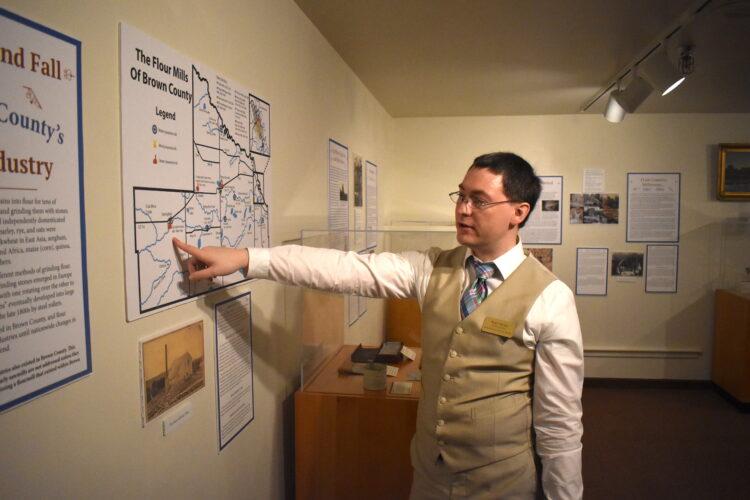Ryan Hallen, Brown County Historical Society Collections Curator, points out the various flour mills on a map created specially for a new exhibit documenting the county’s flour milling history.
NEW ULM – The Brown County Historical Society museum’s newest exhibit showcases the history of flour mills in the area from 1850-1985.
Collections curator Ryan Hallen said the exhibit, located on the second floor, is the latest in the “Brown County Birth” series, which the museum has previously shown on the area’s transportation history and pottery industry.
The museum currently displays a collection of milling artifacts, which Hallen said have been collected since the 1970s.
“We have manufacturing artifacts from the Brown County flour mills,” he said. “We have some millstones from the New Ulm mill. We have marketing artifacts. We have items from the Sleepy Eye Flour Mill, which were used by the Native Americans employed by the mill to promote their flour.”
Many of the artifacts were brought there between the 1970s and 1990s, Hallen said, and one staff member spent time tracking them down and adding them to the museum’s collection.

Ryan Hallen describes two millstones from an early 20th century flour mill in New Ulm as part of a new exhibit at the Brown County Historical Society.
Notable artifacts include two large millstones: one discovered in Riverside Park by the Historical Society and the other donated by the International Multifoods Corporation (IMC).
The millstones at IMC are believed to have come from Eagle Mill, which was located at First Street South and West Valley, and the millstones at Riverside Park came from Grove Mill, which stood where the park now stands.
Eagle Mill, when it was called Empire Mill, burned down in 1910. Charred grain salvaged from the fire is also part of the museum’s exhibits.
Hallen said much of the work that went into the exhibit was tracking down all the mills in Brown County, including some that have only been in operation for a few years, and he didn’t want to focus solely on the big gristmills and flour mills in New Ulm.
The museum is always on the lookout for historical artifacts, and Hallen believes there are more that could contribute to the exhibit.
“There was a big windmill where the funeral home is now,” Hallen says, “that’s the Schramm Mill. It would be fantastic if there were any artifacts left from that mill. It was in operation for nearly 20 years, so it wasn’t a short-lived mill.”
Hallen said the biggest challenge was getting information from old German newspapers that reported on the factory, which he said he struggled to decipher because he doesn’t speak the language fluently.
The exhibit will run from now through spring 2025. For more information, visit https://www.browncountyhistorymn.org/
Get the latest news from the day and more delivered to your inbox
NEW ULM — Brown County commissioners heard the annual 4-H impact report, including the number of youth served.
NEW ULM — Brown County commissioners unanimously approved a resolution Tuesday to ratify a state of emergency in …


